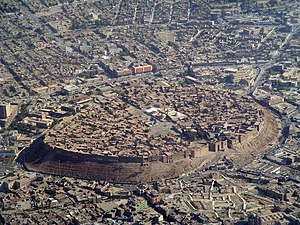Welcome to the city of Erbil
Arbil (also written Erbil or Irbil; BGN: Arbīl; Kurdish: ھەولێر, Hewlêr; Arabic: اربيل, Arbīl;; Syriac: ܐܪܒܝܠ, Arbel) is believed to be one of the oldest continuously inhabited cities in the world and is the third-largest city in Iraq after Baghdad and Mosul. The city lies eighty kilometres (fifty miles) east of Mosul. The city is the capital of the Kurdistan Autonomous Region and the Kurdistan Regional Government.
Ancient history
Urban life at Arbil can be dated back to at least the twenty-third century BC. It was a ancient Assyrian city. Many Kurds probably have Assyrian ancestors, or a mix of Assyrian and Median(Iranian) ancestors. The city's archaeological museum contains only pre-Islamic objects. The name of Arbil appears to be of non-Semitic origin. The initial ar element is a feature of a number of Hurrian place names. The name Arbil was mentioned in the Sumerian holy writings (about 2000 B.C.) as Arbilum, Orbelum or Urbilum. Later, Akkadians based on similarity and folk etymology rendered the name to mean four gods (arba'ū ilū). The city was a centre for the worship of the Assyrian goddess Ishtar. In classical times, the city was known by its Aramaic name, Arbela.
Under Median Empire the Median King Cyaxares settled a number of Sagarthian tribes of Zagros in Arbela and Kirkuk, probably as a reward for their help in capture of Nineveh. After revolts of Medes led by Phraortes king of Media (522-521 BC) were put down by Darius I of Persia, the Sagartians of Arbela rebelled against Darius continuing the Median revolts. Darius sent an army led by a Median general named Takhmaspâda, and in the summer of 521 BC defeated Sagartians, led by Tritantaechmes, who claimed to be a descendant of the Great Median King Cyaxares. According to Darius, the rebel of Arbela was the last revolt of Media which he put down. These incidents are carved on the Behistun Inscription around Kermanshah.
The Battle of Gaugamela, in which Alexander the Great defeated Darius III of Persia in 331 BC, took place about one hundred kilometres (sixty miles) west of Arbil. After the battle, Darius managed to flee to the city, and, somewhat inaccurately, the confrontation is sometimes known as the Battle of Arbela.
The name Hewlêr, is also used for this historic town of Mesopotamia by Kurdish settlers of the city and derives from Horlêr, meaning "Temple of the Sun" in the Kurdish language. This may have originated from the religions of Mithraism, Yazdanism and Zoroastrianism practiced by Kurds in which the sun and fire play a significant role (see also: Helios).
Erbil became, like Amida (Diyarbekr), part of the region disputed between Rome and Persia under the Sassanians. Under Emperor Trajan it was named the Roman province of Assyria, and after a century of independence was reoccupied by Rome. The Jewish kingdom of Adiabene (Greek form Hadyab) had its center at Arbil, and the town and kingdom are known in Jewish Middle Eastern history for the conversion of the royal family to Judaism, although the general population may have remained eclectic but with a strong eastern Christian presence.
Arbela was an early center of Christianity. By AD 100 there was a bishop headquartered in the city. Most of the early bishops had Jewish names, suggesting that most of the early Christians in this city were converts from Judaism.
The queen of the Adiabenians apparently adopted Christianity, and it spread throughout this region, so that the area became a Christian stronghold. It served as the seat of a Metropolitan of the Church of the East. It is known from Butler's Lives of the Saints (see Martyrs of Hadiab) as the site of the Sassanian Persian martyrdom of almost 350 Christians in the year 346.
Tags
The list of tags is empty.
News
Medieval history
07/03/2009 23:49———
Modern history
07/03/2009 23:48———

